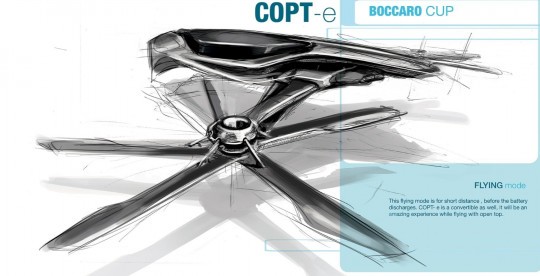Copt-e Is a Hybrid Vehicle that Can Morph Into an E-Vtol with Helicopter Rotors
Some designers, however, look to fill the gaps between machines and come up with all sorts of machines like the one you see in the cover photo. What we are looking at is known as the Crossover Copt-e, and is created by Prathyush Devadas of Wuhan, China. Initially, I didn’t understand what it was, but once I dissected the title too, I realized it’s a crossover helicopter type thingy, and judging by the ‘e’ on the end, it’s probably electric. Turns out it really is, but we’ll get to that shortly.
To start, we have the initial car design. Four wheels, a chassis, and a cab. But the design isn’t one of a full-size vehicle, but rather, a roadster style, with only room for two people. Why only two people? Because as out there as this machine is, the ability of this sort of tech to carry only two people is within limits that current e-Vtols exhibit.
At the front of the vehicle, we can see the chassis underneath, while an entire glass cover that extends all the way over the usual engine compartment allows the possible passengers to enjoy the view while cruising to their destination.
the chassis rises over the wheels and then drops low to create the carriage, while at the end, rises up and tapers off into a sort of teardrop shape. We've seen a similar back-end on the Jaguar Consul, but here it’s a lot slimmer. Why? Because here at the back is also where this vehicle’s transformation happens.
The rear axle of the car hides its most unique feature. While driving, you wouldn’t even know that this vehicle can just stop, transform, and take off vertically. When you need it to, the Copt-e is able to transform the rear axle into a pair of spinning helicopter blades.
Stacked and hidden from view, at the probable push of a button, the rear wheels begin to tuck themselves underneath the rear of the car, while from above the swivel arms, two sets of blades unfold and position themselves somewhat above the car as to produce an effect similar to that of a helicopter. Once those rotors are in place, enjoy your ride.
One thing I enjoyed about this idea is that the designer took in consideration another aspect of electric flight, our current inability to travel very far, thus designating this mode only for short distance travel. But once you’re out of juice what do we do? We keep reading, that’s what.
Unlike other EV’s around, this vehicle doesn’t plug into a grid or any chargers, but rather, deploys its rotors again, this time in a different position, and function like windmills to generate electricity. How long this would take we have no mention as this is still a concept.
Whether or not this vehicle ever takes off is a big question, but I think somebody could possibly rig a car battery to some sort of windmill device and recharge their EV that way. It’s a long shot, I know, but some crazy mechanic has surely thought of it.
To start, we have the initial car design. Four wheels, a chassis, and a cab. But the design isn’t one of a full-size vehicle, but rather, a roadster style, with only room for two people. Why only two people? Because as out there as this machine is, the ability of this sort of tech to carry only two people is within limits that current e-Vtols exhibit.
At the front of the vehicle, we can see the chassis underneath, while an entire glass cover that extends all the way over the usual engine compartment allows the possible passengers to enjoy the view while cruising to their destination.
the chassis rises over the wheels and then drops low to create the carriage, while at the end, rises up and tapers off into a sort of teardrop shape. We've seen a similar back-end on the Jaguar Consul, but here it’s a lot slimmer. Why? Because here at the back is also where this vehicle’s transformation happens.
The rear axle of the car hides its most unique feature. While driving, you wouldn’t even know that this vehicle can just stop, transform, and take off vertically. When you need it to, the Copt-e is able to transform the rear axle into a pair of spinning helicopter blades.
Stacked and hidden from view, at the probable push of a button, the rear wheels begin to tuck themselves underneath the rear of the car, while from above the swivel arms, two sets of blades unfold and position themselves somewhat above the car as to produce an effect similar to that of a helicopter. Once those rotors are in place, enjoy your ride.
One thing I enjoyed about this idea is that the designer took in consideration another aspect of electric flight, our current inability to travel very far, thus designating this mode only for short distance travel. But once you’re out of juice what do we do? We keep reading, that’s what.
Unlike other EV’s around, this vehicle doesn’t plug into a grid or any chargers, but rather, deploys its rotors again, this time in a different position, and function like windmills to generate electricity. How long this would take we have no mention as this is still a concept.
Whether or not this vehicle ever takes off is a big question, but I think somebody could possibly rig a car battery to some sort of windmill device and recharge their EV that way. It’s a long shot, I know, but some crazy mechanic has surely thought of it.














No comments:
Post a Comment